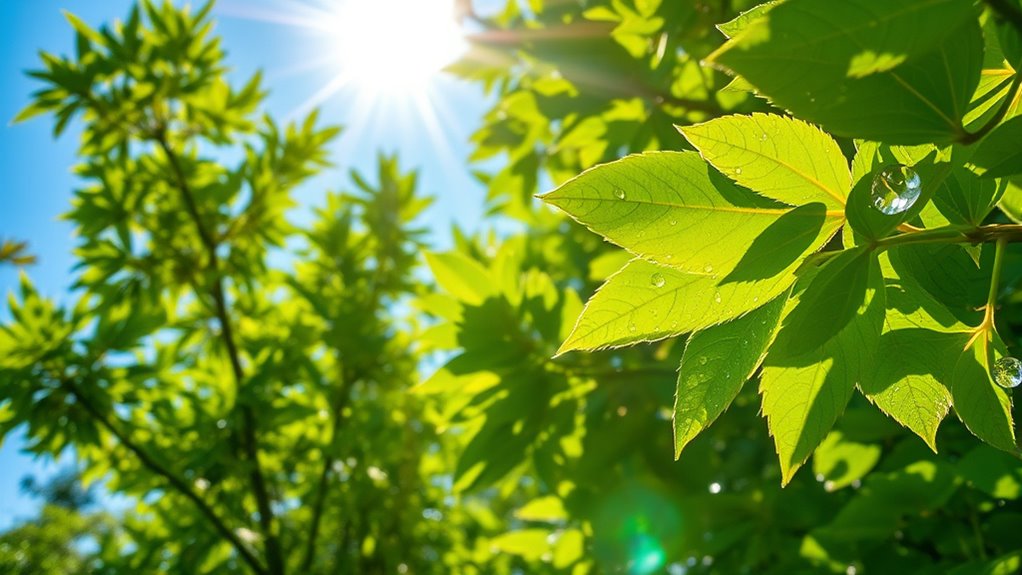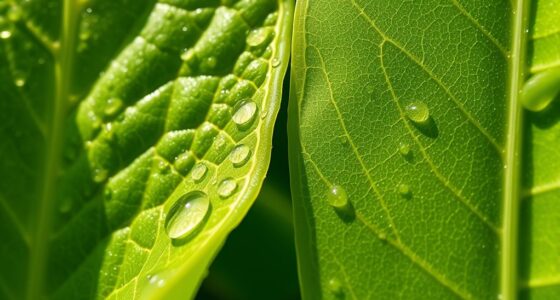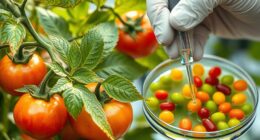Evapotranspiration combines water evaporation from soil and plant surfaces with transpiration from leaves, and it ramps up during summer due to higher temperatures, sunlight, and dry air. As conditions warm, plants open their stomata to perform photosynthesis, losing more water in the process. This increased water loss means plants need extra water to stay healthy, grow, and manage the heat. Want to understand how to support plants through these hot months? Keep exploring to learn more.
Key Takeaways
- Evapotranspiration combines evaporation from soil and transpiration from plants, increasing in hot weather to release water vapor.
- Warm temperatures and intense sunlight accelerate water loss from plants and soil during summer.
- Plants open stomata to facilitate photosynthesis, leading to more water vapor release and cooling but risking dehydration.
- Extra water replenishes what is lost through evapotranspiration, supporting plant health and growth in hot conditions.
- Adequate watering during summer helps maintain internal plant hydration and prevents stress caused by excessive water loss.

Have you ever wondered how water moves from the ground into the atmosphere? It’s a essential part of the plant water cycle, and understanding it can reveal why plants need extra water during summer months. Evapotranspiration is the process that combines two key ways water leaves plants: evaporation from their surfaces and transpiration through their leaves. When the weather warms up, especially in summer, this process accelerates. Sunlight, higher temperatures, and dry air conditions increase the rate at which water vapor escapes from plants and the soil. As a result, plants lose more water, and they need fresh supplies to stay healthy and function properly.
Evapotranspiration speeds up in summer, increasing water loss from plants and soil.
During hot days, plants open their stomata—tiny pores on their leaves—to allow for gas exchange. This action facilitates photosynthesis but also leads to significant water loss through transpiration. When water evaporates from the soil surface and transpires from leaves, it cools the plant, preventing overheating. However, this cooling comes at the cost of water depletion. If the soil moisture isn’t sufficient, plants struggle to maintain their internal balance, which can hamper growth and reduce productivity. That’s why during summer, extra watering becomes critical; it replenishes the water lost through evapotranspiration and ensures plants can continue their essential processes.
Understanding why plants need extra water in summer through the lens of evapotranspiration highlights the delicate balance between water availability and environmental conditions. As temperatures rise, the plant water cycle accelerates, demanding more water to sustain plant health and to mitigate climate impact. It’s a reminder that water management during hot seasons isn’t just about individual plant survival—it’s about maintaining ecological and atmospheric stability. When you water your garden or consider larger landscape planning, recognizing the role of evapotranspiration helps you appreciate the interconnectedness of plants, water, and climate, emphasizing the importance of thoughtful water use during the warmer months. Additionally, increasing awareness of projector contrast ratios can help optimize visual quality in outdoor or indoor settings.
Frequently Asked Questions
How Does Soil Type Affect Evapotranspiration Rates?
Soil type greatly influences evapotranspiration rates through its composition and moisture retention abilities. If your soil is sandy, it drains quickly, reducing moisture availability and lowering evapotranspiration. Conversely, clay soils retain water longer, increasing evapotranspiration due to higher moisture retention. Understanding your soil composition helps you manage watering effectively, ensuring plants get the right amount of water they need, especially during hot, dry periods.
Can Plants Adapt to Reduce Water Loss During Hot Summers?
During hot summers, you can encourage plant adaptation by implementing water conservation techniques. Plants naturally adapt by developing deeper roots or waxy coatings to reduce water loss. You can support this process by mulching around plants to retain moisture and watering efficiently early or late in the day. These strategies help your plants conserve water, making them more resilient to heat stress and reducing overall evapotranspiration.
What Are the Best Practices to Conserve Water in Gardens?
Imagine uncovering secret ways to save water in your garden. You can start with mulching techniques to minimize evaporation and keep soil moist longer. Pair that with drip irrigation, delivering water directly to plant roots efficiently. These methods not only conserve water but also ensure your plants thrive despite summer’s heat. Implementing these practices transforms your garden into a sustainable oasis, proving that smart watering habits make all the difference.
How Does Climate Change Influence Evapotranspiration Patterns?
Climate change impacts evapotranspiration patterns by increasing climate variability and drought frequency. You’ll notice more unpredictable weather, leading to higher temperatures and prolonged dry spells. These changes boost evapotranspiration rates, causing plants to lose water faster and raising their water needs. To adapt, you should adjust watering schedules, mulch heavily, and choose drought-resistant plants, helping your garden thrive despite shifting climate conditions.
Are There Specific Plants That Require Less Supplemental Watering?
You’ll find that drought-tolerant plants and water-efficient species require less supplemental watering. These plants have adapted to survive with minimal water, making them ideal for dry conditions or water conservation efforts. By choosing such plants, you reduce your watering needs and help conserve water during hot, dry seasons. Incorporating drought-tolerant and water-efficient species into your garden guarantees healthy growth while minimizing your water usage.
Conclusion
Understanding evapotranspiration is like knowing why your garden thirsts more in summer. Just as your plants need extra water to stay healthy, the process of water loss through evaporation and transpiration increases with heat. By giving your plants the right amount of water, you’re helping them stay vibrant and strong, just like a well-hydrated person feels energized. Keep an eye on their needs, and you’ll enjoy a lush, thriving garden all season long.










